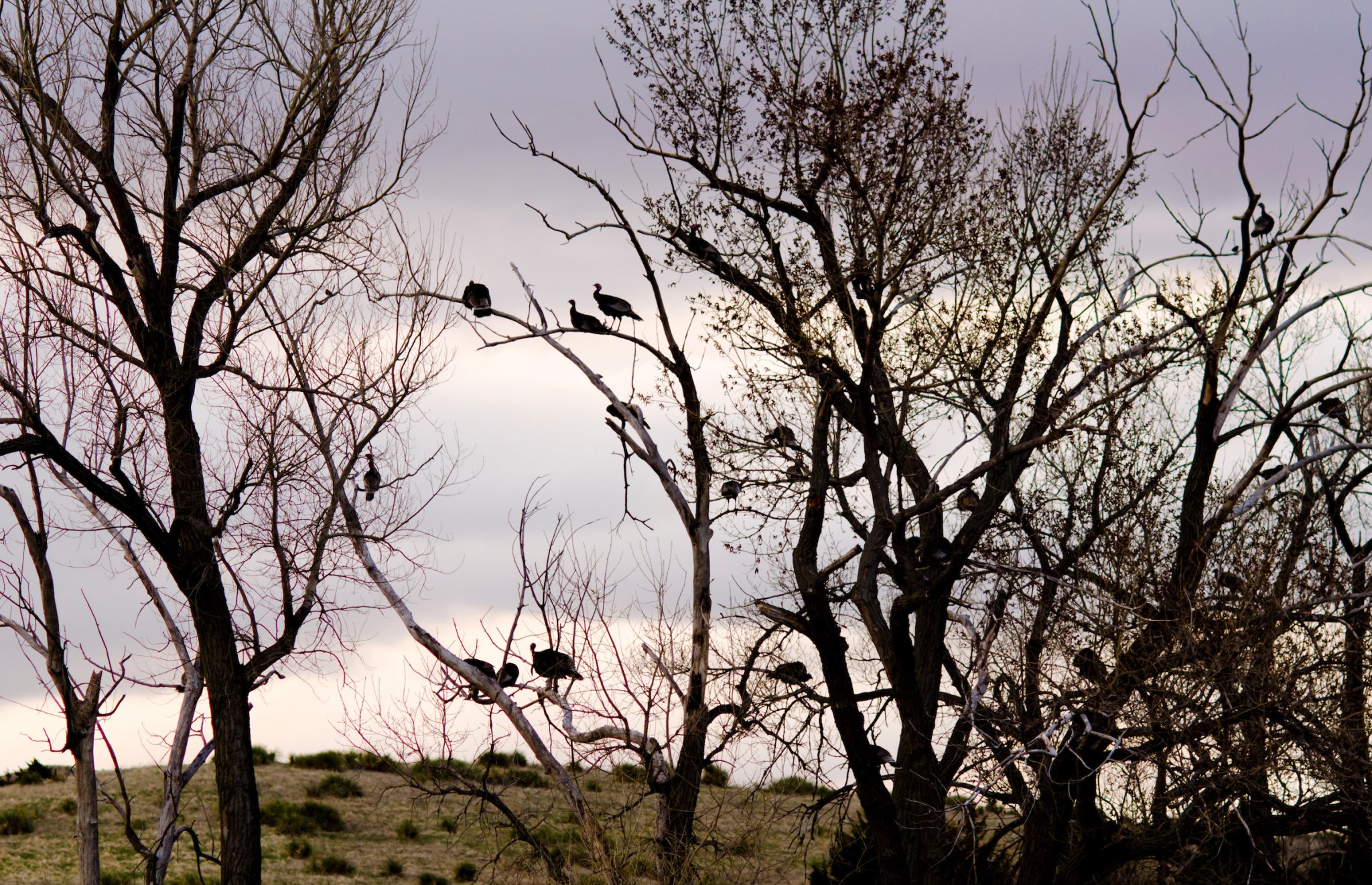We may earn revenue from the products available on this page and participate in affiliate programs. Learn More ›
Roosting a turkey is part science and part art. The science is basic ornithology: study the bird’s behavior, understand its habitat, and pattern its movements. The art is in pinpointing a gobbler’s specific location in a darkening forest, not to mention getting that tom to gobble in the first place.
More simply, roosting a turkey means identifying where the bird (ideally a tom) flies up into a tree to sleep at night. You do this by getting the tom to gobble once he’s on the limb. The next morning, you know exactly where to target him when he flies down. It’s important to know that roosting is not about shooting a turkey out of a tree. That’s illegal in some states, but it’s poor form everywhere. Turkey hunting at its best is about calling in toms and engaging with them at their level.
With that in mind, here’s an ultimate guide to roosting turkeys. We’ll cover:
- Understanding Turkey Roosts
- Where Turkeys Roost
- Get Roosted Turkeys to Gobble
- Tips for Roosting a Turkey
- Hunting Near Turkey Roosts
Whether you’re a new turkey hunter or an experienced gobbler chaser, these tips will help you have more productive morning hunts this spring.
Understanding Turkey Roosts

Turkeys tend to roost in the same area (sometimes the same tree) for multiple nights in a row. But there are no hard-and-fast rules here. A gobbler might roost in the same tree for a week, and then not return there for the rest of the season. Or, a different tom might start roosting in the area. Sometimes a turkey will roost by himself. Other times a tom might roost near a flock of hens with several other toms nearby, too. In the open plains of the West, where good roost trees are few and far between, hundreds of turkeys might roost in the same area.
However, there are a few general rules of thumb to know about turkey roosts:
- Turkeys like to roost in large trees that have branches that run parallel to the ground.
- Certain areas become historic roosts, meaning turkeys will roost there year after year.
- Turkeys roost in areas where they won’t be disturbed.
- Turkeys fly up in the evenings around sunset and fly down in the morning near sunrise.
- Turkeys will rarely move to different roosts in the night (they have poor night vision).
- Turkeys like relatively clear areas to fly up from and fly down to.
- There will be a ton of turkey sign (scratching and droppings) near well-used roosts.
Where Do Turkeys Roost?
Turkeys are looking for seclusion and safety from predators when on the roost. There are several terrain and habitat features around the country that turkeys prefer.
River Bottoms and Pond Edges
Veteran turkey hunters say that turkeys like to roost near water since that means predators can only approach from one direction. Sure, this makes sense, but we’ve never been able to ask a gobbler if that’s actually true. Either way, turkeys do tend to roost near bodies of water. River bottoms with giant cottonwood trees are classic roosting spots. So are old oaks around ponds or marshes.
Field Edges
Turkeys feed in agricultural fields, so it makes sense that they commonly roost along field edges. If you see turkeys using a field first thing in the morning or late in the afternoon, there’s a good chance they’re roosting nearby. Look for the largest trees in the most secluded section of the field.
READ NEXT: What Do Turkeys Eat?
Ridge Tops and Hilltops
Turkeys will take the high ground whenever they get the chance. Ridge tops that are hard to access, have mature trees, and relatively open woods are prime roosting spots. Turkeys will also roost along the sides of ridges or hills. They’ll walk to the top, or almost to the top, and they fly horizontally off the ridge to roost in limbs along its side.
Draws, Gullies, Hollers
In cold, windy weather, turkeys will commonly roost in draws to get out of the elements. This is especially true in Western open country where the best roost trees are commonly found in draws.
Stands of Mature Pine
Likewise, turkeys will often roost in mature pines for shelter. Think giant white pines in the Midwest and Northeast and loblolly pine in the South (plus cypress trees). In the West, mid-slope ponderosa pines make great roosting spots.
Get Roosted Turkeys to Gobble

Once you’ve identified likely roosting areas using digital mapping apps or with good old boots-on-the-ground scouting, it’s time to check if turkeys actually roost there. One way to do this is early in the morning before your season starts. Go out before dawn, sneak within a few hundred yards of where you expect turkeys to be roosted, and then listen for them. If they haven’t gobbled on their own, you can get them to shock gobble with a call (more on this in a moment).
During the season, you can use similar tactics in the evening (though turkeys seem to gobble less often at dusk than they do at dawn). Hit a handful of spots where you expect turkeys to be roosting and coax a shock gobble out of them. The key is to be sneaky. Don’t let the turkeys see or hear your approach. If they do, they likely won’t gobble, no matter what kind of calls you make. But assuming you’re able to get within a few hundred yards of a roost site undetected, use the following calls to strike a gobble.
Box Call
Zink Hick Talker Box Turkey Call
A loud, high-pitched box call is great for producing shock gobbles. Remember, you’re not trying to call the tom in with this call, you’re just trying to get him to gobble. Start quietly with a run of four to six yelps. Listen for about two minutes. Then rip off a run of eight to 10 yelps. Listen again. If all is still quiet, start yelping and then finish with a few aggressive cuts. For striking toms, I go with Zink’s Hick Talker box call.
READ NEXT: Best Turkey Calls
Barred Owl Hoot
Woodhaven Calls Custom Calls Ninja Owl
Barred owls are found throughout the East, Midwest, South, and Pacific Northwest and their “who cooks for you, who cooks for y’all” really gets turkeys to gobble. You can read all about why turkeys gobble at owls here. With a little practice, you can make realistic owl hoots with your voice. Don’t worry about sounding exactly like an owl; the turkeys don’t really care.

However, there are also a variety of owl hoot calls out there, with Woodhaven’s being among the best. Owl hoots and box calls are my two favorite methods for striking roosted toms.
Coyote Howls
Primos Randy Anderson Signature Series Hot Dog Predator Call
A high-pitched coyote howl is an aggressive way to get turkeys to gobble if the first two methods fail. I don’t like to howl close to a roost, but I will try it for striking a gobbler at long range or on especially windy evenings.
Crow Calls
Woodhaven Custom Calls The Real Crow
Crow calls are more commonly used to strike gobblers during the doldrums of midday, but they work fine for roosting turkeys too. Like the coyote call, I’ll only use crow calls when other methods fail.
Tips for Roosting a Turkey
Getting a turkey to gobble is just the beginning. Use these tips to roost like an expert.
Triangulate a Gobbler
You want to know exactly where the gobbler is roosted. To do this, get him to gobble two or three times. Mark where you think he’s roosted using a digital mapping app. If you’re not sure of his exact location, move to a different side of the roost (making sure to keep plenty of distance) and strike him again. Does your original waypoint still seem accurate? Hearing a turkey gobble from a different angle will make it easier to get his exact location.
Don’t Get Too Close
The worst thing you can do while roosting is bomb into a roost site and blow the turkeys out of it. So keep a safe distance from where you expect the roost to be. In thick woods this might be 200 yards. In mature woods or open country this could mean 600 yards or more.
Be Sneaky
Treat a roosting mission just like a hunt. Walk quietly, wear camo, and don’t skyline yourself. Staying stealthy keeps you from busting turkeys, but it also helps you hear toms that gobble on their own.
Play the Wind
Calm evenings are ideal for roosting. Turkeys will still gobble in high wind, but it’s harder to hear them, and it’s harder for them to hear you. On calm evenings, turkeys will sound closer than they really are. On windy evenings, turkeys will sound farther away than they really are.
Use Your Ears
If you’re having a hard time telling where a gobble came from, turn slightly and point your ear in the most likely direction. Then, try to strike the gobbler again. In layman’s terms, we are able to determine the direction of a noise when sound waves hit one ear before the other. So it’s often hard for us to tell if a noise came directly in front of us or directly behind us. If you’re roosting with a buddy, you should both face in slightly different directions to pinpoint a gobble.
Get Away from Roads
Everybody and their brother can drive country roads, throw open the truck door, owl hoot, and then keep driving. Turkeys catch on to this pattern, and they’ll either stop gobbling at these drive-by’s or they’ll move deeper into the woods. Also, if you do happen to strike a gobbler off a public road, there’s a good chance another hunter will be on that bird, too.
Listen from Above
Hilltops and ridges where you can hear gobbles from far off are ideal spots to start roosting. If you hear a very distant gobbler, try to move closer to pinpoint him.
Bring Binoculars
In the early season before green-up, you can spot turkeys in trees from a surprising distance with a good pair of binoculars. Getting eyes on the bird will help you know exactly what tree he is in, but also if he’s roosted by himself or if there are hens (or other toms) around.
Stay Late
Sometimes turkeys won’t gobble until after sunset. Many hunters give up on their roosting missions too soon into the evening. Stay till it’s dark and you just might hear that one lone gobble, which is oftentimes all you need.
Listen for Fly-Up
Sometimes turkeys simply won’t want to gobble. But on calm, quiet evenings you can hear them fly up into their roost trees. Turkeys aren’t the most graceful fliers and their large wings produce loud flapping. If you’re quiet, and fairly close to the roost, you’ll be able to hear them fly up.
Hunting Near Turkey Roosts

Unfortunately, roosted does not always mean roasted. Roosting a turkey is great, but you’ve still got to slip into the area the next morning, call him in, and kill him.
Go in at dark and take your time. You’ll have to move slowly to avoid making noise. You should also avoid using a headlamp when you get anywhere near the roost. Turkeys can see your light from far away (remember, they have a high vantage point in a tree).
Once you get to your spot, don’t nosily mess around with decoys or cut shooting lanes. Just get setup and sit there quietly. Let the tom gobble on his own before you even think about calling.
Aaron Warbritton from the Hunting Public has some solid tips on calling to roosted toms in the video below.

Sometimes a gobbler will fly down and come charging right in. But more often, he’ll wander around near his roost tree and then find real, live hens. Sometimes you’ll be able to call the whole flock to you. Other times the boss hen will shut you down and walk off, bringing the gobbler with her.
READ NEXT: Turkey Hunting Tips from the Pros
Even when that happens, your roosting effort hasn’t been a bust. Assuming you haven’t spooked the birds, you can move a little closer and maybe pull that tom from his hens later in the day. Or you’ll draw in a sub-dominant tom that doesn’t have any hens. Through careful roosting and smart hunting around roost sites, you will ensure that you’re in the game all day. Plus, there’s a good chance those turkeys will be coming back to the same area (maybe even the same tree) that evening.





